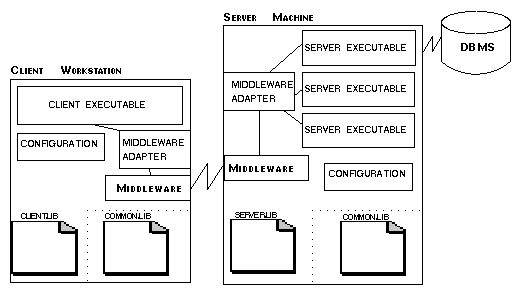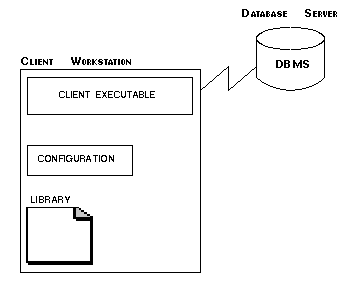




 | Application Development |     |
With Panther, you can start with a simple, client/server, two-tier architecture application and when your application requirements increase, convert your application to three-tier architecture. Or, begin with an distributed application structure—create both the client and server components at the same time.
Components of a Panther Application |  |
A typical three-tier Panther application, consisting of the following Panther tools and application components, is illustrated in Figure 4-1.

Figure 4-1 Components of an enhanced, three-tier client/server Panther application.
JetNet is Panther's middleware product; middleware adapters are also available for Oracle Tuxedo and WebSphere Application Server. On Windows, you can deploy COM components in your Panther application using COM, DCOM, and MTS.
A three-tier JetNet/Oracle Tuxedo application also has:
Some of these components also exist in simpler, two-tier applications: the database, client executables, client library, and configuration files.

Figure 4-2 Components of a two-tier client/server Panther application.
Building Two-Tier Applications |  |
A two-tier application is distributed between client machine and the database server. The client machine controls the presentation logic and all or most of the application logic. The client can access data in the database through SQL interactions (coded or application-generated) or by making calls to the database's stored procedures.
prodev/prodev32.exe), and create a repository (default name is data.dic).
Building Distributed Applications |  |
Distributed applications separate the business logic of the application from the user interface. The application logic is built into service components that reside on the application or component server. The client workstations provide the presentation interface, some application logic, and can make requests to the application servers to perform commonly used logic and access a database. Using service requests, there is no need for a continuous connection between the client and the database server.
The following steps summarize the process for JetNet/Oracle Tuxedo applications:
server.lib, client.lib and common.lib.

Figure 4-3 Components of a Panther JetNet/Oracle Tuxedo development environment includes access to local and remote libraries as well as direct and remote access to the database.
The following steps summarize the process for component-based applications:
Building a Component-based Application
To build a component-based application:
prol5w32.ini and the environment settings as needed to recognize the installation and locate files needed by Panther.
prodev32.exe), and create a repository (default name is data.dic).



